1. Project Introduction
BOB (Build on Bitcoin) is a hybrid second-layer platform that combines the security of Bitcoin and the flexibility of Ethereum smart contracts, supporting Bitcoin ecosystems such as Ordinals, Lightning and Nostr, aiming to improve the practicality of Bitcoin and expand its functionality.
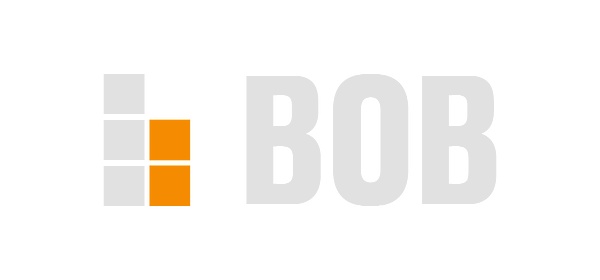
In short, BOB aims to inspire a renaissance in Bitcoin construction by supporting innovations on Bitcoin's existing stack, including the Lightning Network, the Sequence Number System and Nostr. The vision of the project is to enhance the value accumulation of Bitcoin in the long term and improve the economic sustainability of the protocol by promoting convolutional technology (especially zero-knowledge convolution). BOB will also support a variety of cryptographic primitives to provide a space for innovators to build and experiment.
BOB's core values include supporting experimentation and innovation, ensuring real-world impact, and providing freedom of choice. The project is still in its early stages, but an early Alpha version has been released, and research and development and experimentation will continue in the future, including new ways to bridge trustlessly between Bitcoin, Ethereum, and multi-chain ecosystems.
BOB's first version of the minimum viable product (MVP) already has a trustless BTC bridge and a built-in Bitcoin light client, which can cryptographically verify the main chain, allowing the team to create trustless Bitcoin primitives such as BTC serial numbers and BRC exchanges.
2. Operation Mechanism
2.1 Merged Mining
The merged mining technology of the BOB project is a key mechanism that allows Bitcoin miners to support the BOB network at the same time without incurring additional costs. The main advantage of this technology is that it can utilize existing Bitcoin mining resources while enhancing the security of the BOB chain.
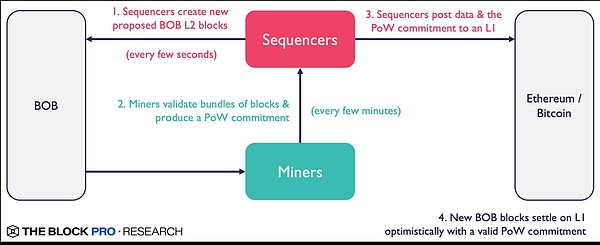
Here is a more detailed explanation of this technology:
2.1.1 Principle and Operation
Merged mining allows two different blockchains - in this case Bitcoin and BOB - to share the same Proof of Work (PoW) algorithm. In practice, miners can mine blocks of the BOB chain while mining Bitcoin. This is achieved by including the information of the BOB block as a small part of the Bitcoin block (usually an additional data field).
2.1.2 Technical Details
In BOB's merged mining protocol "Optimine", miners generate a proof of work that meets the mining difficulty requirements of both networks at the same time. Miners need to find a hash value that meets the difficulty requirements of the Bitcoin network, and this hash value also needs to meet the difficulty requirements of the BOB network, or the conditions that are easier to meet. When a Bitcoin block is mined, it also implies a valid BOB block, so this BOB block will also be considered to have been mined.
2.1.3 Security
Through merged mining, BOB is able to take advantage of the Bitcoin network's broad miner base and high security. Because the verification of BOB blocks is carried out simultaneously through Bitcoin's PoW mechanism, any attempt to attack the BOB network requires simultaneously attacking the Bitcoin network, which is very challenging economically and technically.
2.1.4 Efficiency and Incentives
This technology allows miners to use the same computing work to provide security support for both networks without the need for additional energy consumption. This not only improves energy efficiency, but also reduces the economic cost of participating in multiple networks.
Merged mining provides an additional incentive for miners, as they can receive additional mining rewards on the BOB chain without sacrificing Bitcoin mining returns. This mechanism encourages more miners to participate in the security maintenance of the BOB network, while also enhancing the overall security and decentralization of the network.
2.2 EVM Compatibility
The Ethereum Virtual Machine (EVM) compatibility of the BOB project is one of its core features, enabling it to support the running of smart contracts and the development of complex decentralized applications (DApps). This feature greatly expands the capabilities of Bitcoin, transforming it from a platform primarily used for value storage and simple transactions to a richer and more diverse application platform.
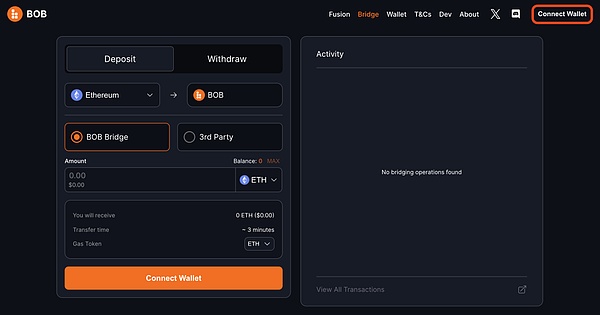
Here is a more detailed introduction to BOB EVM compatibility:
2.2.1 Basic Concepts
EVM is the runtime environment for executing all smart contracts on Ethereum. It is a completely isolated virtual environment, which means that the code running in EVM can be executed without any external influence. This compatibility allows BOB to leverage existing Ethereum tools and infrastructure, such as the smart contract programming language Solidity, as well as development tools Hardhat and Remix, and BlockScout and The Graph for data visualization.
2.2.2 Technical Implementation
The way BOB achieves EVM compatibility is by integrating EVM in its L2 solution. This means that any DApps and smart contracts originally designed for Ethereum can theoretically run on the BOB platform without modification. In this way, BOB is able to take advantage of the maturity and extensive developer community of the Ethereum ecosystem while bringing the advantages of Bitcoin security.
2.2.3 Developing and deploying smart contracts
Developers can use standard Ethereum development tools to create, test and deploy smart contracts to the BOB network. These contracts can interact with users through standard Ethereum wallets such as MetaMask. In addition, BOB supports simplified user interaction through Metatransactions and account abstraction, allowing users to pay transaction fees with BTC or other ERC-20 tokens.
2.2.4 Cross-chain functionality
EVM compatibility also enables BOB to support interoperability with Ethereum and other EVM-based chains. For example, users can use existing Ethereum infrastructure and markets to trade assets created on BOB, or migrate assets from Ethereum to BOB.
2.2.5 Advantages and Challenges
BOB brings many advantages through EVM compatibility, including plug-and-play smart contract support, access to a wider range of developer tools and community resources, and a richer DApp ecosystem. However, this also brings challenges, especially security and efficiency issues when ensuring seamless integration with the Bitcoin main chain.
2.3 Cross-chain Functionality
The cross-chain functionality of the BOB project is one of its core features, which greatly enhances the interoperability between the Bitcoin and Ethereum ecosystems. By implementing cross-chain technology, BOB can not only support seamless transactions between Bitcoin and Ethereum, but also link to other EVM-based networks.
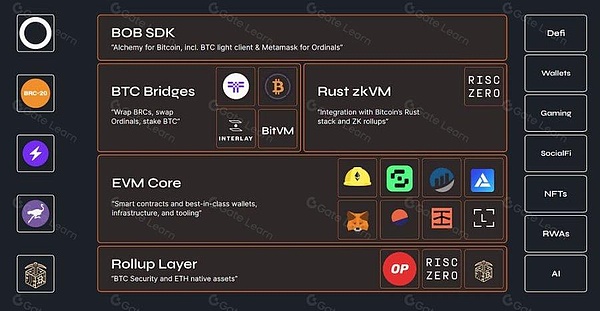
The following is a more detailed introduction to BOB's cross-chain functions:
2.3.1 Cross-chain Bridge
BOB implements one or more cross-chain bridges that allow transfers and interactions between Bitcoin and other blockchain assets (such as ERC-20 tokens on Ethereum). These bridges utilize smart contracts to lock assets on one chain and issue corresponding tokens on another chain. For example, users can lock Bitcoin on the BOB platform and receive an equal amount of wrapped Bitcoin (wBTC) on the Ethereum network.
2.3.2 Two-way light client BTC bridge
BOB particularly emphasized the development of its two-way light client BTC bridge, an advanced cross-chain solution that supports direct interaction between the Bitcoin and Ethereum ecosystems. This bridge uses light client technology to verify Bitcoin transactions on the EVM, allowing the direct use and management of Bitcoin without the need for centralized custodian services.
2.3.3 Metatransactions and Account Abstraction
BOB enhances its cross-chain capabilities by introducing meta-transactions and account abstraction. Meta-transactions allow users to pay transaction fees without having to own native network tokens (such as ETH) when making transactions. This means that Bitcoin users can use BTC to pay transaction fees on the Ethereum network, increasing the convenience and accessibility of cross-chain operations.
2.3.4 BTC light client and smart contract interoperability
BOB uses BTC light client technology to allow smart contracts to access and process Bitcoin blocks and transaction data. This allows smart contracts created on the BOB platform to interact directly with Bitcoin and perform operations such as P2P exchanges, serial number auctions, or computing power tokenization.
2.3.5 Rust and zk-SNARKs
BOB's cross-chain functionality also benefits from its support for the Rust programming language and zero-knowledge proofs (especially zk-SNARKs). This allows BOB to perform off-chain computations while verifying the correctness of these computations on the chain, providing a secure and trusted verification mechanism for complex cross-chain operations.
2.3.6 Security and Efficiency
When designing cross-chain functionality, BOB pays special attention to security and efficiency. Trust and risk in cross-chain transactions are minimized by using advanced encryption technology and carefully designed protocols. In addition, BOB's cross-chain bridge is designed to reduce latency and transaction costs, allowing users to move assets quickly and economically.
3. Ecosystem
Fusion Points and Airdrop of the BOB project are key mechanisms within its ecosystem to incentivize and reward user participation. These features not only encourage active participation in the community, but also increase the liquidity and user base of the platform.
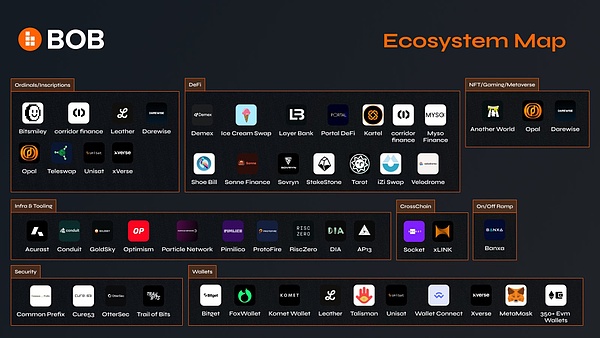
3.1 Fusion Points
Fusion Points are an incentive within the BOB network that rewards users for their contribution and participation in the network. Users can earn Fusion Points in a variety of ways, such as:
Asset Bridging: Users can earn Fusion Points by bridging whitelisted assets (such as wBTC and tBTC, etc.) to the BOB platform. These operations usually have high multipliers, meaning participants can earn more points through active transactions.
TVL (Total Locked Value) Contribution: Users who lock assets in decentralized applications (DApps) that support whitelisted assets can earn fusion points based on the locked amount and time.
Active DApp Interaction: Users can also earn fusion points by interacting with specific whitelisted DApps, such as participating in voting, staking, or other forms of interaction.
Referral Program: Users can also earn fusion points by recommending new users to join the BOB platform. The more referrals, the higher the potential rewards.
3.2 Airdrop
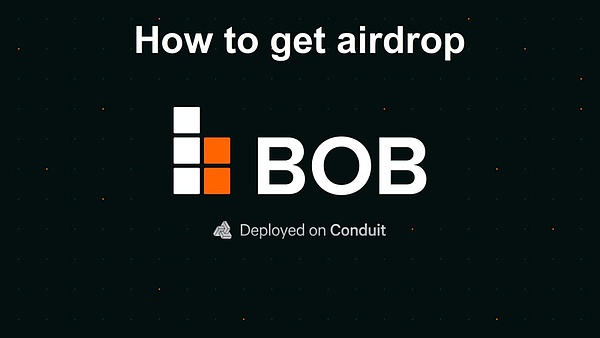
In the BOB project, airdrops are usually combined with fusion point activities, and the methods include:
Fusion point conversion: The fusion points accumulated by users can eventually be converted into tokens of the BOB project, which can be traded on various trading platforms, or used for further operations and investments within the platform.
Community activity rewards: Users who participate in specific community activities or complete specific tasks may directly receive airdrops as rewards.
Contribution rewards: Users who have made significant contributions to the BOB ecosystem, such as developers or active community members, may also receive airdrops to recognize their contributions.
4. Roadmap
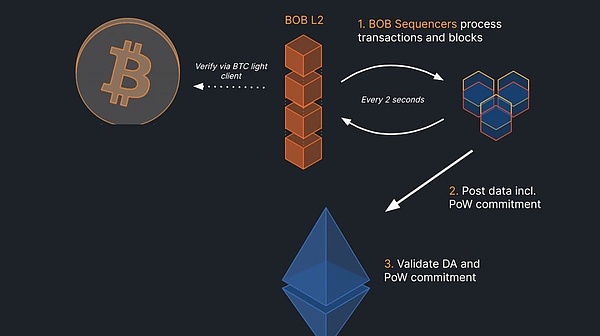
The BOB project’s roadmap details its multi-stage deployment plan, which mainly includes the following stages:
Phase 0: Public Testnet
This is the initial stage of the BOB project, focusing on the deployment of the test network and the verification of basic functions. The purpose of this stage is to ensure that the system’s infrastructure is stable and ready for the next stage of implementation.
Phase 1: Bootstrapping BOB - Optimistic ETH Rollup
In this phase, BOB will implement an optimistic Ethereum Rollup solution. This means that all transactions and state transitions will initially be verified and settled on Ethereum's L1, but with the potential to move to a more efficient system in the future.
Phase 2: Inheriting Bitcoin Security through a New Merged Mining Protocol
This phase will see Bitcoin's PoW security integrated into the BOB project through merged mining technology. Doing so ensures that the BOB network inherits Bitcoin's high security standards while maintaining high transaction processing efficiency.
Phase 3: Upgrading from Optimistic Rollup to ZK Verification
ZK-Rollups offer higher efficiency and security than Optimistic Rollups. The goal of this phase is to reduce the need for trust in network validators and significantly increase transaction throughput and speed by using zero-knowledge proofs to verify transactions and state changes.
Phase 4: BTC Staking Sorter via BitVM, One-Time Signatures, and ZK Proofs
This phase will introduce more advanced features such as the Bitcoin Virtual Machine (BitVM), one-time signature mechanism, and ZK proofs, all of which are intended to further enhance the security and decentralization of cross-chain interactions.
Phase 5: Multi-ZK-Rollup (Connecting ETH and BTC at the same time)
The final phase aims to create a multi-ZK-Rollup that connects to both the Bitcoin and Ethereum chains, which will greatly enhance the flexibility and efficiency of cross-chain operations, making BOB a truly multi-chain platform.
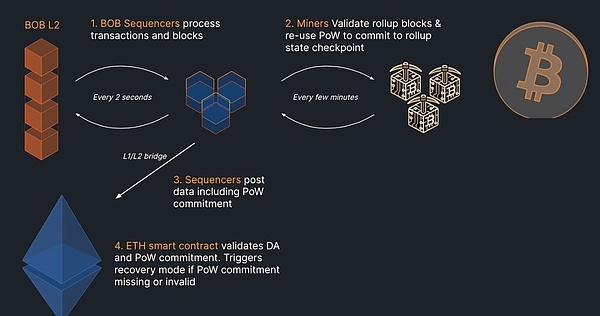
Such a roadmap shows the ambition and complexity of the BOB project, which aims to solve existing scalability and interoperability problems by gradually introducing advanced blockchain technology. The successful implementation of each stage requires overcoming major technical challenges, but if successful, it will greatly promote the development of the entire blockchain industry, especially in improving Bitcoin functions and integrating with other blockchain systems.
5. Team/Financing
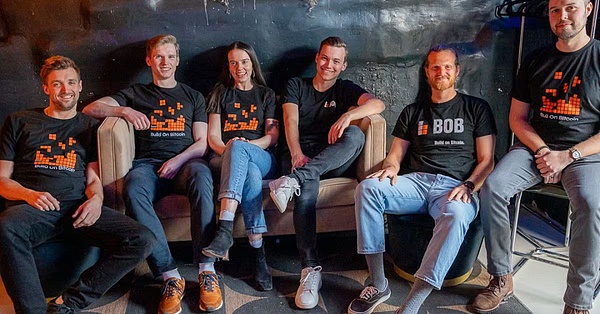
Dominik Harz is the co-founder and CTO of Interlay and BOB. He holds a PhD in Computer Science from Imperial College London and previously worked as a research assistant there.
Alexei Zamyatin is the co-founder of Interlay and BOB and was previously a researcher at SBA Research. He is a PhD candidate at the Center for Cryptocurrency Research and Engineering at Imperial College London, with a research focus on blockchain security and interoperability.
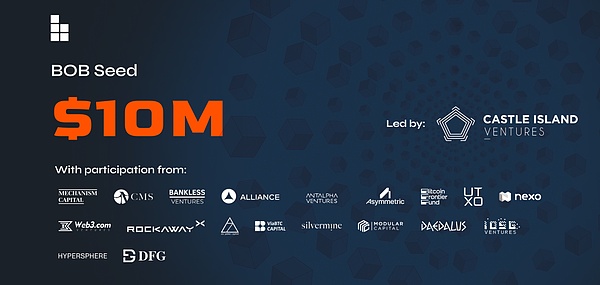
Recently, BOB received a $10 million seed round led by Castle Island Ventures. Other participants include Mechanism Ventures, Bankless Ventures, CMS Ventures and UTXO Management, as well as angel investors such as Dan Held and Domo, the creator of the BRC-20 token standard.
This financing supports BOB's goal of enhancing Bitcoin infrastructure without compromising performance by enabling off-chain computation and on-chain verification (similar to Ethereum's optimistic rollups), thereby facilitating scalable smart contract applications on Bitcoin.
6. Project Evaluation
6.1 Track Analysis
The BOB project is positioned in the field of Bitcoin's second-layer solutions and DeFi (decentralized finance), especially in promoting interoperability between Bitcoin and Ethereum ecosystems. By combining the security of Bitcoin and the smart contract function of Ethereum, BOB aims to expand the functionality of Bitcoin to support complex financial applications, which is not possible on the traditional Bitcoin network. The following is an analysis of the main tracks of the BOB project and some similar projects:
6.1.1 The Track of the BOB Project
Bitcoin Second Layer Solution: BOB provides higher transaction speeds and lower transaction fees than the native Bitcoin network by implementing second-layer technologies such as merged mining and smart contracts, while maintaining core security properties.
Cross-chain technology: By providing compatibility with EVM and building cross-chain bridges, BOB makes interoperability between Bitcoin and other blockchain assets (especially Ethereum and its tokens) possible, which greatly increases the application potential of Bitcoin in areas such as DeFi.
Smart Contract Platform: BOB supports EVM, allowing developers to deploy and execute smart contracts on Bitcoin, which was originally a significant feature of Ethereum, and can now be realized in the Bitcoin ecosystem through platforms such as BOB.
6.1.2 Similar Projects
RSK (Rootstock): RSK is the first project to bring Ethereum smart contract functionality to Bitcoin. It is a Bitcoin sidechain that allows the Bitcoin network to directly support smart contracts and more complex transaction types.
Lightning Network: Although mainly used for payments and microtransactions, Lightning Network is another second-layer expansion solution for Bitcoin that enables high-speed and low-cost transactions by establishing a network of payment channels.
Liquid Network: Liquid, developed by Blockstream, is a Bitcoin sidechain that is mainly used to accelerate Bitcoin transactions and issue other types of digital assets.
Stacks: Formerly known as Blockstack, Stacks aims to bring smart contracts and decentralized applications to the Bitcoin network through its unique Clarity smart contract language and Proof of Transfer (PoX) consensus mechanism.
6.2 Project Advantages
1. Security
BOB uses Bitcoin's Proof of Work (PoW) security model and provides the same level of security as Bitcoin through merged mining technology. This means that any attempt to attack BOB must also be sufficient to attack Bitcoin itself, which is almost impossible in practice because Bitcoin's network is currently the largest and most secure PoW network.
2. DeFi and Smart Contract Applications
BOB not only supports basic Bitcoin transactions, but also enables complex financial tools and services (such as lending platforms, automated market makers (AMMs) and stablecoins) to be implemented on Bitcoin through smart contracts. This expands the scope of Bitcoin's application and makes it a more comprehensive financial solution
3. Innovative financing and community incentive mechanisms
The BOB project encourages community participation and network growth through integration points and airdrop mechanisms. These incentives not only increase user participation, but also help maintain and develop BOB's ecosystem.
4. Open and scalable architecture
BOB's architecture is designed to support future upgrades and expansions, including support for new cryptographic primitives and technologies such as zero-knowledge proofs and off-chain computing solutions. This ensures that BOB can adapt to future market needs and technological developments.
6.3 Project Insufficiency
1. Complexity and Difficulty of User Adoption
Although BOB simplifies the user experience through familiar interfaces such as MetaMask, the complexity of its underlying technology—especially involving smart contracts and cross-chain interactions—may pose a challenge to new users. This complexity may limit the participation of non-technical users, thereby affecting the widespread adoption of the project.
2. Dependence on External Factors
BOB's success depends heavily on its compatibility and interoperability with Ethereum and other blockchain technologies. Any major changes or incompatible updates on these external platforms may have an adverse impact on BOB.
3. Difficulty of project execution and technical implementation
Realizing the technical functions and ecosystem described by BOB requires a high level of technical expertise and strict project management. Any mistakes or delays in the implementation process may affect the overall success and market acceptance of the project.
7. Conclusion
In summary, the BOB project, as an innovative Bitcoin second-layer solution, greatly expands the application field of Bitcoin by integrating the security of Bitcoin with the smart contract function of Ethereum, and provides the possibility of cross-chain functions and DeFi applications. It incentivizes community participation through mechanisms such as fusion points and airdrops, and strives to build an active and supportive ecosystem.
Despite facing many challenges such as technical complexity, security challenges and fierce market competition, the innovative ideas and functional expansion of the BOB project provide new perspectives and possibilities for the future application of Bitcoin. With the continuous advancement of blockchain technology and the gradual maturity of the market, the BOB project has the potential to play a key role in promoting Bitcoin and the entire cryptocurrency ecosystem into a new stage.
 JinseFinance
JinseFinance














